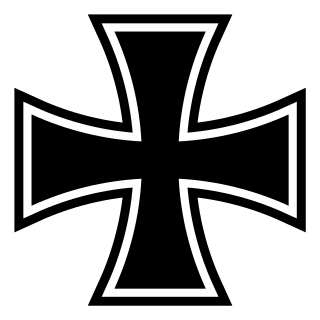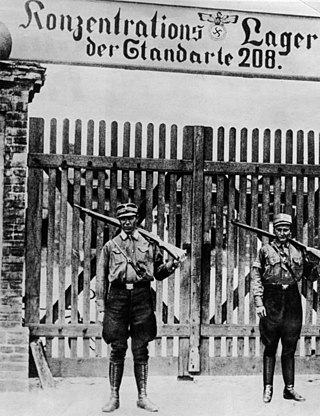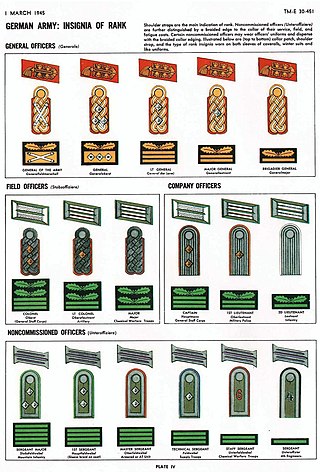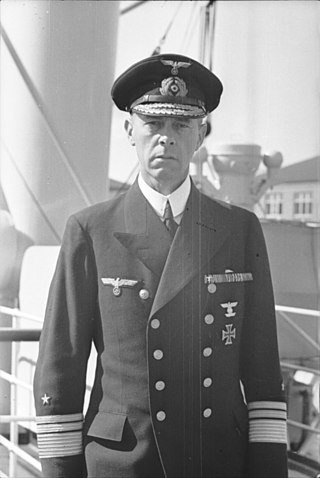
The ranks and insignia of the German Red Cross (Deutsches Rotes Kreuz, abbr. DRK) were the paramilitary rank system used by the national Red Cross Society in Germany during World War II.

The ranks and insignia of the German Red Cross (Deutsches Rotes Kreuz, abbr. DRK) were the paramilitary rank system used by the national Red Cross Society in Germany during World War II.


Men's uniforms and insignia of the German Red Cross (Deutsches Rotes Kreuz, DRK) during the Nazi era would include helmets with special decals with the Red Cross eagle. Likewise, belt buckles were also issued with the same eagle. [1] [2]

| Shoulder insignia [3] | Name [3] | Translation | Heer equivalent [4] |
|---|---|---|---|
| | Generalhauptführer | General chief leader | Generalleutnant |
| | Generalführer | General leader | Generalmajor |
| | Oberstführer | Colonel leader | Oberst |
| | Oberfeldführer | Senior field leader | Oberstleutnant |
| | Feldführer | Field leader | Major |
| Hauptführer | Chief leader | Hauptmann | |
| Oberwachführer | Senior watch leader | Oberleutnant | |
| Wachführer | Watch leader | Leutnant | |
| Enlisted | |||
| | Haupthelfer mit Zugführer Prüfung | Head helper with platoon exam | Stabsfeldwebel |
| | Haupthelfer | Head helper | Oberfeldwebel |
| | Oberhelfer | Senior helper | Feldwebel |
| | Vorhelfer mit Gruppenführer Prüfung | Front helper with group leader exam | Unterfeldwebel |
| | Vorhelfer | Front helper | Unteroffizier |
| | Helfer | Helper | Gefreiter |
| Anwärter | Candidate | Soldat | |

| Collar insignia [5] | Name [4] | Translation | Heer equivalent [4] |
|---|---|---|---|
| Generalhauptführerin | General chief leader | Generalleutnant | |
| Generalführerin | General leader | Generalmajor | |
| Oberstführerin | Colonel leader | Oberst | |
| Oberfeldführerin | Senior field leader | Oberstleutnant | |
| Feldführerin | Field leader | Major | |
| Hauptführerin | Chief leader | Hauptmann | |
| Oberwachführerin | Senior latch leader | Oberleutnant | |
| Wachführerin | Watch leader | Leutnant | |
| Haupthelferin | Head helper | Oberfeldwebel | |
| Oberhelferin | Senior helper | Feldwebel | |
| Vorhelferin | Front helper | Unteroffizier | |
| Anwärter | Candidate | Soldat |

The Iron Cross was a military decoration in the Kingdom of Prussia, and later in the German Empire (1871–1918) and Nazi Germany (1933–1945). The design, a black cross pattée with a white or silver outline, was derived from the insignia of the medieval Teutonic Order and borne by its knights from the 13th century. As well as being a military medal, it has also been used as an emblem by the Prussian Army, the Imperial German Army, and the Reichswehr of the Weimar Republic, while the Balkenkreuz variant was used by the Wehrmacht. The Iron Cross is now the emblem of the Bundeswehr, the modern German armed forces.

The Bundeswehr is the armed forces of the Federal Republic of Germany. The Bundeswehr is divided into a military part and a civil part, the military part consisting of the German Army, the German Navy, the German Air Force, the Joint Support Service, the Joint Medical Service, and the Cyber and Information Domain Service.

The uniforms and insignia of the Schutzstaffel (SS) served to distinguish its Nazi paramilitary ranks between 1925 and 1945 from the ranks of the Wehrmacht, the German state, and the Nazi Party.
Fascist symbolism is the use of certain images and symbols which are designed to represent aspects of fascism. These include national symbols of historical importance, goals, and political policies. The best-known are the fasces, which was the original symbol of fascism, and the swastika of Nazism.

The uniforms and insignia of the Sturmabteilung (SA) were Nazi Party paramilitary ranks and uniforms used by SA stormtroopers from 1921 until the fall of Nazi Germany in 1945. The titles and phrases used by the SA were the basis for paramilitary titles used by several other Nazi paramilitary groups, among them the Schutzstaffel (SS). Early SS ranks were identical to the SA, since the SS was originally considered a sub-organisation of the Sturmabteilung.

Ranks and insignia were used by the National Socialist German Workers' Party (NSDAP) as paramilitary titles between approximately 1928 and the fall of Nazi Germany in 1945. Such ranks were held within the political leadership corps of the Nazi Party, charged with the overseeing of the regular Nazi Party members.
National Socialist paramilitary ranks were pseudo-military titles, which were used by the Nazi Party, between 1920 and 1945. Since the Nazi Party was by its very nature a paramilitary organisation, by the time of World War II, several systems of paramilitary ranks had come into existence for both the Nazi Party itself and various Nazi paramilitary organisations.

The War Order of the German Cross, normally abbreviated to the German Cross or Deutsches Kreuz, was instituted by Adolf Hitler on 28 September 1941. It was awarded in two divisions: in gold for repeated acts of bravery or military leadership; and in silver for distinguished non-combat war service. The German Cross in Gold ranked higher than the Iron Cross First Class but below the Knight's Cross of the Iron Cross, while the German Cross in Silver ranked higher than the War Merit Cross First Class with Swords but below the Knight's Cross of the War Merit Cross with Swords.

The German Red Cross is the national Red Cross Society in Germany.

The Spanish Cross was an award of Nazi Germany given to German troops who participated in the Spanish Civil War, fighting for nationalist general, later Spanish caudillo, Francisco Franco.
DRK may refer to:
Hans Ritter von Lex (1893-1970) was a German political figure and the President of the German Red Cross from 1961 to 1967. He was born Hans Lex on October 27, 1893, in Rosenheim, Upper Bavaria, Germany. He died February 26, 1970, in Munich, Germany.
The German Strafgesetzbuch in section § 86a outlaws "use of symbols of unconstitutional and terrorist organizations" outside the contexts of "art or science, research or teaching". The law does not name the individual symbols to be outlawed, and there is no official exhaustive list. However, the law has primarily been used to outlaw fascist, Nazi, communist, Islamic extremist and Russian militarist symbols. The law, adopted during the Cold War, most notably affected the Communist Party of Germany, which was banned as unconstitutional in 1956, the Socialist Reich Party, which was banned in 1952, and several small far-right parties.

The Verein für Deutsche Kulturbeziehungen im Ausland, abbreviated VDA, is a German cultural organisation. During the Nazi era it was engaged in spying across the whole world, using German minorities living in other countries. Its other goals included preservation of German culture among "racial Germans".

The Heer as the German army and part of the Wehrmacht inherited its uniforms and rank structure from the Reichsheer of the Weimar Republic (1921–1935). There were few alterations and adjustments made as the army grew from a limited peacetime defense force of 100,000 men to a war-fighting force of several million men.

The Kriegsmarine was the navy of Nazi Germany prior to and during World War II. Kriegsmarine uniform design followed that of the preexisting Reichsmarine, itself based on that of the First World War Kaiserliche Marine. Kriegsmarine styles of uniform and insignia had many features in common with those of other European navies, all derived from the British Royal Navy of the 19th century, such as officers' frock coats, sleeve braid, and the "sailor suit" uniform for enlisted personnel and petty officers.
The comparative ranks of Nazi Germany contrasts the ranks of the Wehrmacht to a number of national-socialist organisations in Nazi Germany from 1933 to 1945 in a synoptic table. Nazi organisations used a hierarchical structure, according to the so-called Führerprinzip, and were oriented in line with the rank order system of the Wehrmacht.
The ranks and insignia of the German Women's Auxiliary Services were the ranks given to women who served in the German military and paramilitary forces during World War II.

Elsbeth von Keudell (1857–1953) was a German nurse and senior coordinator of the Countess Rittberg Sisters' Association of the Red Cross. She was one of the first people to receive the Florence Nightingale Medal for her service to those in need.

Bärbel Nehring-Kleedehn or Bärbel Kleedehn was a German politician from the CDU party.